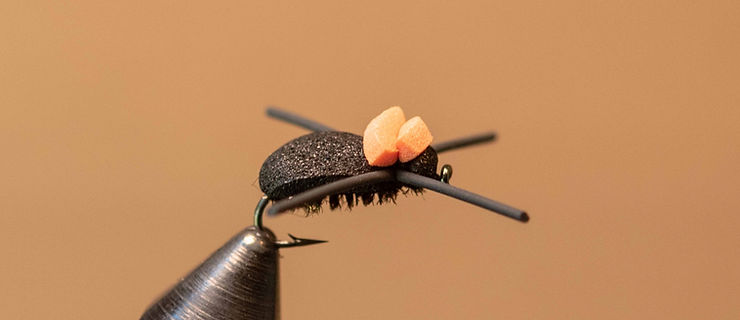What is a Flybrary?

The first time I saw a Flybrary was on Kettle Creek, near the lower limit of the project area. Stuck in this little panel were numerous flies, some in a seriously chewed up state, and others that looked as if they’d just been plucked from a bin at the local fly shop. Although that particular Flybrary is no longer there, it left an impression, and something about it seemed perfectly right.
Fly fishermen connect over many things, including the flies we use. It’s the most taboo and yet frequently asked question on the stream — what are they hitting?
I’ve had more conversations with strangers about fly patterns than I have any other topic. In a sense, Flybraries are an extension of that conversation. Before even tying on a fly, we may check out the Flybrary, if one is present, to see what others have left behind and base our fly choice on that. Or you might look it over just to see what others had luck with.
This is assuming, of course, that someone would actually leave behind their favorite pattern. The cynic in me wonders, “Are people putting their good flies on these things, or are Flybraries just a form of deception?” Maybe how you answer that will depend on if you believe human nature is inherently good or inherently evil. And to be perfectly honest, it probably depends on the day!
What is a Flybrary?
A Flybrary is akin to those mini libraries you sometimes see around town. Or maybe those little dishes of pennies near every cash register, the ones with the slogan “Need one? Take one. Have one? Leave one.” It’s a neat concept. If you’ve had a good day on the water on a particular fly, leave it behind for others to try. Leaving behind our lucky flies for people we’ve never met with the intent to actually help them catch more fish is an honorable gesture, and I imagine even God has to look down and smile at that kind of charity!
I also love the idea of creating a potential gathering place where you can run into other anglers and start up conversations. And if by chance you forget your fly box at home (which I’ve done!) a Flybrary can save your arse. It may not provide the best fly for the occasion, but it can at least salvage the day.
The Flybrary Project
The idea for Flybraries was a grassroots project created by Larry Littrell and a couple friends. In an interview on flylords.com, Littrell says they got the idea from stickers. “We were peppering a gas pump with fly fishing related stickers and one day I saw some old foam tape on the pump so I stuck a couple of flies on the foam and posted a story on Instagram that simply said; “free to a good home”. Within a few days, the two flies were taken, but were also replaced (still don’t know by whom). That process continued to repeat itself for a month or two until one afternoon I put a Seadek fly patch on the pump and my buddy Carl Granger and I posted another story, this time with him saying ‘Have one leave one, need one, take one…'” You can read the full interview on flylords.com here.
The Flybrary Project website has an interactive map listing the location of numerous Flybraries across the country. This isn’t a complete directory, but it’s probably pretty close. It also has information about how to start an official Flybrary on your local stream.
Although there are many benefits associated with Flybraries, I do see one drawback that nobody really talks about – what happens when a bird lands on a Flybrary and decides to eat one of the flies? My only criticism for the project is the potential risk to wildlife. Covering the Flybrary with glass or enclosing it in some kind of box would solve this issue.

(Photo: I started tying this particular foam-bodied beetle because of the Flybrary on Yellow Breeches Creek.)
What I’ve Learned at the Flybrary
When I first saw a Flybrary, I thought there wasn’t a chance anyone would actually leave one of their favorite flies on it. That thought was reinforced by the flies I usually found on these things. Some were tattered beyond recognition, barely a few wraps of thread and chenille on a hook – throw-away flies, in other words. Some were “impressionistic”, to put it mildly, while others resembled nothing at all. I didn’t find my first really useful pattern until I fished Yellow Breeches Creek behind Allenberry Resort one morning and plucked a foam-bodied beetle from that Flybrary and used it to catch a handful of trout. I was sure to put it back, as well as a few other favorites from my box, before I left.
The more I encounter Flybraries, the more I believe the flies are left behind with good intentions. But I have found a lot of patterns that were obviously someone’s crazy concoction. Check out some of these patterns and you can see that some fly fishermen use some mighty strange patterns. Of course, that doesn’t mean those flies won’t catch fish. Something I’ve noticed, though, is that Flybraries located near popular waters – Yellow Breeches Creek, for instance – tend to have better selections.
I’m reminded of a box of flies a reader once sent me. It contained about a dozen patterns that he swore were killer on trout and bass. I wasn’t so sure, as they looked like they’d been pieced together in a crafting class, with glass beads and tinsel and the occasional feather jutting up at an odd angle — all tied on over-sized streamer hooks. They sat in my desk drawer for months. And then, one day, I figured what the heck, why not give them a shot. And the suckers worked great! I caught some really nice smallmouth bass on those flies.
My point is this: a fly doesn’t have to look nice to catch fish, and beauty (as they say) is in the eye of the beholder. And fly fishermen use the darndest things! In this way, Flybraries have made me more aware of the uniqueness of each fisherman’s fly box, and it’s very likely that no two have the same patterns.
Every now and then I pluck a pattern from the Flybrary to use at some point throughout the day. I try to pick ones that I’d never buy or tie, ones that look a little weird, like they’re someone’s personal creation. Sometimes they work and sometimes they don’t, same as any fly in my box, I guess.
One of the things about fly fishing that has always fascinated me is that, on any given day, you can pick a random fly from your stash and catch a trout. Other days it takes a specific pattern tied and fished a certain way to catch that same trout. And if it’s true that most of the patterns on a Flybrary were used successfully by the one who left it, then I’d say those days when a trout will take anything are a lot more common than we all realize, and maybe all that really matters is how that fly is fished.
And maybe that’s what Flybraries are really all about. They’re a conversation piece, a gathering place for fishermen to share flies and stories about the thing they enjoy most. In that regard, I’d say they are a huge success.
How about you? Have you ever used a fly from a Flybrary to catch fish? Have you ever left a productive fly behind for others to try? I’d love to hear your thoughts in the comments below.
Sign up for the Dark Skies Fly Fishing e-newsletter
It's free, delivered to your inbox approximately three times each month.
Sign Up Now
I love the idea of this in general…it suggests a culture of gentlemen outdoorsmen very different from the jabroni sitting on a plaster bucket and littering styrofoam bait boxes on the ground.